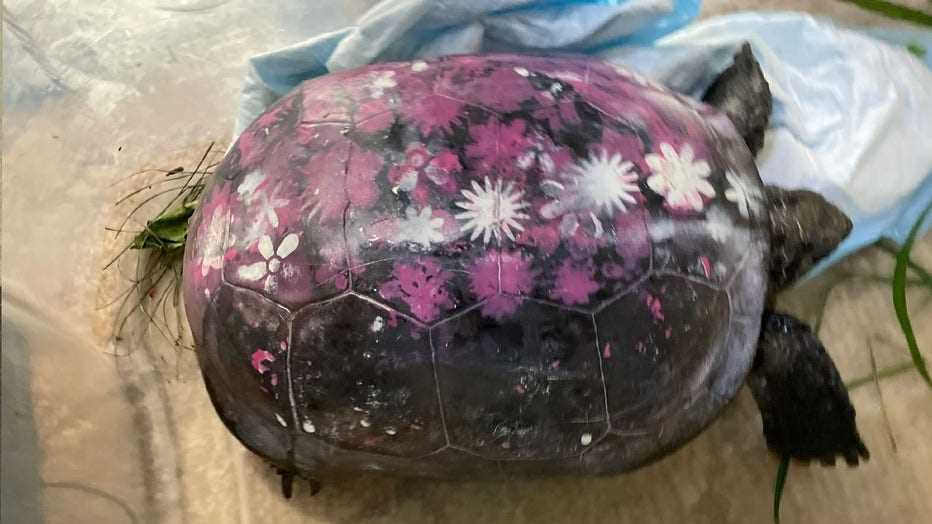The shell of a painted turtle not only serves as a form of protection, but also plays a crucial role in its overall health and well-being. The shell provides support for the turtle’s body and organs, as well as helping with thermoregulation. It also acts as a camouflage, allowing the painted turtle to blend in with its surroundings and avoid predators.
The shell is made up of several layers, including the outer layer called the scutes. These scutes are made of keratin, the same substance that makes up our hair and nails. The scutes are hard and help to protect the turtle from predators and other dangers.
The shell also consists of bony plates called the carapace and plastron. The carapace is the top part of the shell, while the plastron is the bottom part. These plates are connected by a flexible hinge, which allows the turtle to retract its head and limbs inside the shell for added protection.
The painted turtle shell is known for its beautiful patterns and colors. The carapace is usually dark green or black, with yellow or red markings. These markings can vary greatly between individuals, making each turtle’s shell unique.
The shell has a series of scales that cover its surface. These scales not only add to the turtle’s pattern and coloration, but they also provide an additional layer of protection. They help to repel water and can prevent the growth of algae and other organisms on the shell.
The shell plays a crucial role in the painted turtle’s survival. It provides the turtle with both physical protection and an effective camouflage. The pattern and color of the shell allow the turtle to blend in with its surroundings, making it difficult for predators to spot them.
Distinctive Features of the Painted Turtle Shell

The painted turtle shell is a fascinating aspect of this reptile’s anatomy. It serves as both a colorful and protective exterior that distinguishes it from other turtles. The shell is hard and composed of several bony plates called scutes. These scutes are covered in a layer of keratin, which gives the shell its unique texture and appearance.
One of the most striking aspects of the painted turtle shell is its vibrant colors. The shell typically features a combination of bright red, orange, and yellow markings, which are set against a dark brown or black background. These colors are not only aesthetically pleasing but also serve as a form of camouflage in their natural habitat.
The patterns on the painted turtle shell can vary between individuals, making each turtle’s shell unique. Some turtles may have symmetrical patterns, while others may have more random and asymmetrical markings. These patterns not only provide a visual appeal but also serve as a way for scientists and enthusiasts to identify individual turtles.
In addition to its colors and patterns, the painted turtle shell also has a distinct shape. It is streamlined and slightly domed, allowing the turtle to maneuver easily in water. The shell is designed to offer protection against predators and harsh environmental conditions.
The shell is made up of interconnected bony plates that provide excellent strength and rigidity. This allows the painted turtle to retreat into its shell when it feels threatened, providing a strong barrier against potential harm. However, unlike some other turtle species, the painted turtle cannot fully retract its head and limbs into its shell.
Caring for a Painted Turtle Shell

The painted turtle is known for its colorful and intricate shell, which provides protection for the turtle’s body. The shell is hard and made up of a series of bony plates, covered by keratinized scales. These scales have a unique pattern, with different shades of green, yellow, and red, creating a beautiful design.
Proper care of a painted turtle shell is essential to ensure the turtle’s health and well-being. Here are some important tips to consider:
2. Providing Proper UVB Lighting: Painted turtles need access to UVB light in order to produce vitamin D3, which is essential for the absorption of calcium. A UVB light source, such as a fluorescent bulb, should be provided in the turtle’s habitat.
3. Maintaining a Healthy Diet: A balanced and nutritious diet is crucial for the health of a painted turtle’s shell. Offer a variety of foods, including commercial turtle pellets, leafy greens, insects, and small fish. Calcium supplements may also be necessary to ensure proper shell growth.
5. Providing a Suitable Habitat: The turtle’s habitat should include a basking area, where the turtle can dry off and absorb heat. The water temperature should be maintained at around 75-80 degrees Fahrenheit (24-27 degrees Celsius), and the water level should be deep enough for the turtle to fully submerge.
By following these care guidelines, you can ensure that your painted turtle’s shell remains healthy and beautiful. Remember to provide a safe and stimulating environment for your turtle, as well as regular veterinary check-ups to catch any potential issues early on.

I’m Lena Adams—a product of an unconventional upbringing in the African wilderness. My father, a daring explorer of African wildlife, sparked my fascination with reptiles, a passion that intertwined with the tragic loss of my mother during an expedition, leaving an indelible mark on my life. Driven to understand the creatures that captivated my parents, I embarked on my journey, sharing insights about reptiles, frogs, and lizards on my website. Through my explorations and conservation efforts, I honour my family’s legacy while seeking connections—to the creatures, nature, and the mother whose presence I yearn to understand.
